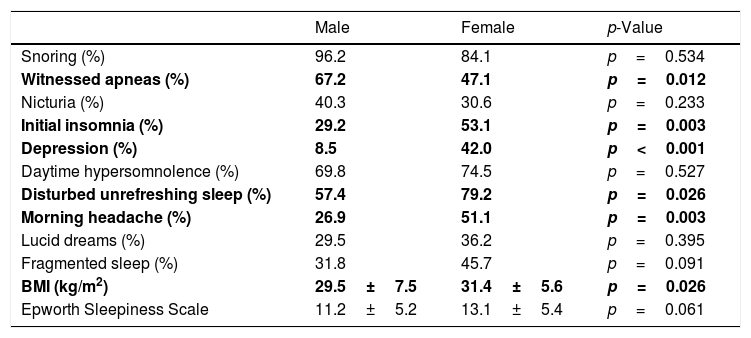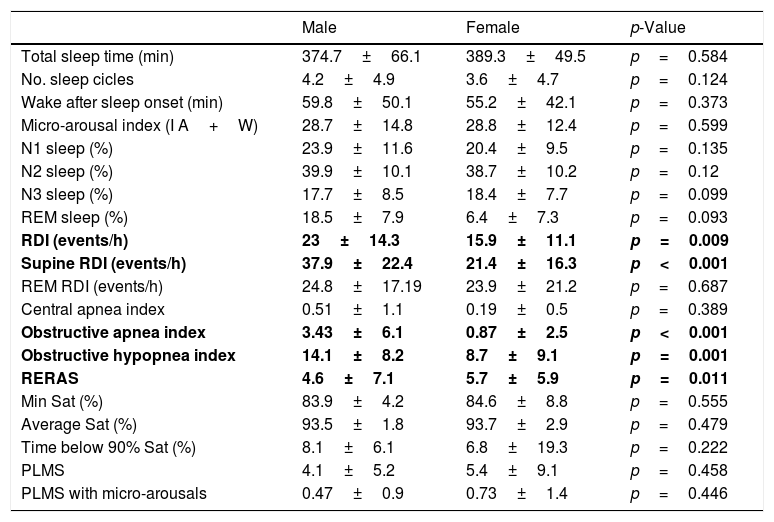Obstructive sleep apnea (OSA) is a serious public health disease because it has adverse physical, psychological and socioeconomic consequences. Different studies have shown that people with this pathology have an increased risk for traffic accidents, hypertension, cardiovascular morbidity and impaired health-related quality of life.1
Traditionally, OSA has been seen as a male disease. However, gender influences its pathophysiology and clinical presentation. According to Heinzer et al., the prevalence of OSA is about 23.4% in women and 49.7% in men.2 Estimates show that women have a higher incidence in the age group above 65 years, increasing the prevalence after menopause, while in men it occurs between 45 and 64 years of age.3 Community based studies have shown that the male to female ratio is in the range of 2:1 to 4:1.3 Differences in symptoms between men and women, particularly the reluctance of women to acknowledge OSA symptoms, contribute to the lower diagnosis in women.4
Hormones are implicated in some gender-related variations, with differences between men and women decreasing as age increases.5 Research has also documented gender differences in the structure and physiological behavior of the upper airway, in craniofacial morphology, in the pattern of fat deposition and respiratory stability.6 In regard to polysomnography parameters, women tend to have less severe OSA, with a lower apnea-hypopnea index (AHI) and shorter apneas.7 Episodes of upper airway resistance and flow limitation that do not meet the criteria for apneas are more common in women.
Therefore, the importance of OSA in women is increasingly being recognized, along with a number of significant gender-related differences in the symptoms, diagnosis, consequences and treatment of OSA.
We here present a prospective analysis which included all men and women with clinically suspected OSA, aged 30–50 years, diagnosed using conventional polysomnography (PSG) in our sleep unit throughout one year (2017). In this year our center did 384 PSG. Clinical data including OSA related symptoms, anthropometric data and PSG parameters were considered. Statistical analysis was carried out using the IBM SPSS® statistical program, version 25 (the Statistical Package for the Social Sciences). Percentages were used for the categorical variables and mean and standard deviation for quantitative variables. All associations between gender, symptoms, anthropometric data and PSG parameters were established using Chi-Square Test or Fisher Exact Test for categorical variables and T Test for independent samples or Mann Whitney Test for continuous variables. All tests were considered significant when its p-value did not exceed 0.05.
We included 189 patients, 72% of men, with a mean age, Body Mass Index (BMI) and Respiratory Distress Index (RDI) of 43.5±5.4 years, 30.1±5.1 and 21.1±19.7, respectively. Symptoms referred to by the patients were different between genders, with men having more frequent witnessed sleep apnea (67.2% vs 47.1%, p=0.017) while women experienced more initial insomnia (53.1% vs 29.2%, p=0.005), depression (42% vs 8.5%, p<0.001), disturbed unrefreshing sleep (79.2% vs 57.8%, p=0.026) and morning headache (51% vs 26.9%, p=0.004), Table 1. In this context, it is important to understand why men and women experience different AOS-related symptoms. Snoring is the most sensitive and strongest predictor of OSA in both genders. Although we did not obtain statistically significant differences, our results also show that snoring is more frequent in men than in women. We think that snoring and witnessed sleep apnea is underreported by women because it is still socially unacceptable. The fact that events in women are less exuberant, with a lower AHI, shorter apneas, less severe OSA, and more episodes of upper airway resistance and flow limitation which do not meet the criteria for apneas, also may have contributed to these results.
Clinical features gender differences.
| Male | Female | p-Value | |
|---|---|---|---|
| Snoring (%) | 96.2 | 84.1 | p=0.534 |
| Witnessed apneas (%) | 67.2 | 47.1 | p=0.012 |
| Nicturia (%) | 40.3 | 30.6 | p=0.233 |
| Initial insomnia (%) | 29.2 | 53.1 | p=0.003 |
| Depression (%) | 8.5 | 42.0 | p<0.001 |
| Daytime hypersomnolence (%) | 69.8 | 74.5 | p=0.527 |
| Disturbed unrefreshing sleep (%) | 57.4 | 79.2 | p=0.026 |
| Morning headache (%) | 26.9 | 51.1 | p=0.003 |
| Lucid dreams (%) | 29.5 | 36.2 | p=0.395 |
| Fragmented sleep (%) | 31.8 | 45.7 | p=0.091 |
| BMI (kg/m2) | 29.5±7.5 | 31.4±5.6 | p=0.026 |
| Epworth Sleepiness Scale | 11.2±5.2 | 13.1±5.4 | p=0.061 |
Several studies have investigated the association of OSA with depression and anxiety. However, the relationship is still poorly understood. In our study we think that the depressive symptoms maybe more related to insomnia, excessive daytime sleepiness and disturbed unrefreshing sleep than to nocturnal hypoxemia. It may explain why women are more likely to have depressive syndrome. We did not find any differences in co-morbidities and current medications. Moreover, in women, it is essential to treat insomnia to achieve compliance with continuous positive airway pressure (CPAP) treatment.
With regard to polysomnographic parameters, men had higher mean values of RDI (23 vs 15.9, p=0.009), supine RDI (37.9 vs 21.4, p<0.001), obstructive apnea index (3.4 vs 0.9, p<0.001), obstructive hypopnea index (14.1 vs 8.7, p=0.001) while women had higher Respiratory Effort Related Arousals (RERA, 5.7 vs 4.6, p=0.011), Table 2. An important reported parameter is wake after sleep onset, also known as “WASO”. This refers to periods of wakefulness occurring after defined sleep onset and it is a reflection of sleep fragmentation. This parameter measures wakefulness, excluding the wakefulness occurring before sleep onset and it can justify the fact that women complain more of initial insomnia and WASO is not different.
Polysomnographic gender differences.
| Male | Female | p-Value | |
|---|---|---|---|
| Total sleep time (min) | 374.7±66.1 | 389.3±49.5 | p=0.584 |
| No. sleep cicles | 4.2±4.9 | 3.6±4.7 | p=0.124 |
| Wake after sleep onset (min) | 59.8±50.1 | 55.2±42.1 | p=0.373 |
| Micro-arousal index (I A+W) | 28.7±14.8 | 28.8±12.4 | p=0.599 |
| N1 sleep (%) | 23.9±11.6 | 20.4±9.5 | p=0.135 |
| N2 sleep (%) | 39.9±10.1 | 38.7±10.2 | p=0.12 |
| N3 sleep (%) | 17.7±8.5 | 18.4±7.7 | p=0.099 |
| REM sleep (%) | 18.5±7.9 | 6.4±7.3 | p=0.093 |
| RDI (events/h) | 23±14.3 | 15.9±11.1 | p=0.009 |
| Supine RDI (events/h) | 37.9±22.4 | 21.4±16.3 | p<0.001 |
| REM RDI (events/h) | 24.8±17.19 | 23.9±21.2 | p=0.687 |
| Central apnea index | 0.51±1.1 | 0.19±0.5 | p=0.389 |
| Obstructive apnea index | 3.43±6.1 | 0.87±2.5 | p<0.001 |
| Obstructive hypopnea index | 14.1±8.2 | 8.7±9.1 | p=0.001 |
| RERAS | 4.6±7.1 | 5.7±5.9 | p=0.011 |
| Min Sat (%) | 83.9±4.2 | 84.6±8.8 | p=0.555 |
| Average Sat (%) | 93.5±1.8 | 93.7±2.9 | p=0.479 |
| Time below 90% Sat (%) | 8.1±6.1 | 6.8±19.3 | p=0.222 |
| PLMS | 4.1±5.2 | 5.4±9.1 | p=0.458 |
| PLMS with micro-arousals | 0.47±0.9 | 0.73±1.4 | p=0.446 |
In conclusion, a growing evidence suggests that there are substantial differences between females and males in the symptoms, diagnosis and consequences of OSA. Our study shows statistical significant differences between genders in both clinical and polysomnographic parameters. Initial insomnia, depression, disturbed unrefreshing sleep, morning headache and higher Respiratory Effort Related Arousals index were noted in women. Men have more frequent witnessed sleep apnea as well as higher apnea, hypopnea and total RDI values. Better knowledge of gender differences in OSA will help to improve the awareness and diagnosis of OSA in women. The development and availability of therapeutic options that take into account these differences, could have the potential to improve outcomes for patients.









